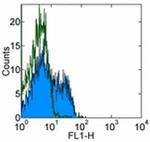Search Thermo Fisher Scientific
Invitrogen
CD314 (NKG2D) Monoclonal Antibody (5C6), eBioscience™
FIGURE: 1 / 1
CD314 (NKG2D) Antibody (14-5879-82) in Flow

Product Details
14-5879-82
Species Reactivity
Published species
Host/Isotype
Class
Type
Clone
Conjugate
Form
Concentration
Purification
Storage buffer
Contains
Storage conditions
Shipping conditions
RRID
Product Specific Information
Description: The 5C6 monoclonal antibody reacts with the human NKG2D, a 42 kDa lectin-like molecule expressed by NK cells, gammadelta T cells, some CD4^+ and CD8^+ T cells. Human NKG2D forms complexes with DAP10, a membrane adaptor protein, and has the ability to costimulate multiple NK activation receptors. The counter-receptor for human NKG2D has been identified as MICA/MICB expressed on epithelial tumors from lung, breast, kidney, ovary, prostate and colon carcinoma. 5C6 and 1D11 block binding of soluble MICA to gammadelta TCR T cell clones and inhibit lysis by these cells. 5C6 and 1D11 induced NKG2D function of redirected lysis of FcReceptor bearing P815 cells.
Applications Reported: The 5C6 antibody has been reported for use in flow cytometric analysis, immunoprecipitation, and immunohistochemical staining. It has also been reported in inhibition of ligand binding in in vitro assays. Please use Functional Grade purified 5C6, Product # 16-5879, in functional assays.
Applications Tested: The 5C6 antibody has been tested by flow cytometric analysis of normal human peripheral blood cells. This can be used at less than or equal to 0.5 µg per test. A test is defined as the amount (µg) of antibody that will stain a cell sample in a final volume of 100 µL. Cell number should be determined empirically but can range from 10^5 to 10^8 cells/test. It is recommended that the antibody be carefully titrated for optimal performance in the assay of interest.
Purity: Greater than 90%, as determined by SDS-PAGE.
Aggregation: Less than 10%, as determined by HPLC.
Filtration: 0.2 µm post-manufacturing filtered.
Target Information
Natural killer (NK) cells are lymphocytes that can mediate lysis of certain tumor cells and virus-infected cells without previous activation. NK cells can regulate specific humoral and cell-mediated immunity, and preferentially express several calcium-dependent (C-type) lectins, which have been implicated in the regulation of NK cell function. The NK gene encodes a member of the NKG2 family, and the encoded transmembrane protein is characterized by a type II membrane orientation (extracellular C terminus) and the presence of a C-type lectin domain. The NKG2 gene family is located within the NK complex, a region that contains several C-type lectin genes preferentially expressed in NK cells.
For Research Use Only. Not for use in diagnostic procedures. Not for resale without express authorization.
Bioinformatics
Protein Aliases: CD314; Killer cell lectin-like receptor subfamily K member 1; killer cell lectin-like receptor subfamily K, member 1; natural killer cell receptor; NK cell receptor D; NKG2-D type II integral membrane protein; NKG2-D-activating NK receptor
Gene Aliases: CD314; D12S2489E; KLR; KLRK1; NKG2-D; NKG2D
UniProt ID: (Human) P26718
Entrez Gene ID: (Human) 22914

Performance Guarantee
If an Invitrogen™ antibody doesn't perform as described on our website or datasheet,we'll replace the product at no cost to you, or provide you with a credit for a future purchase.*
Learn more
We're here to help
Get expert recommendations for common problems or connect directly with an on staff expert for technical assistance related to applications, equipment and general product use.
Contact tech support
